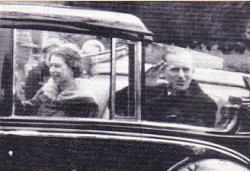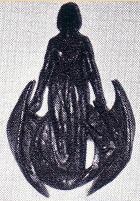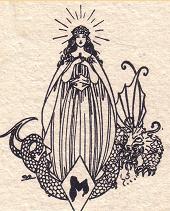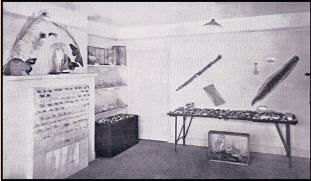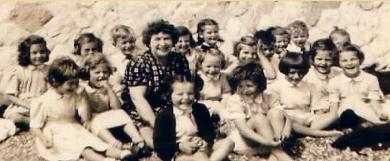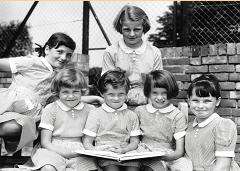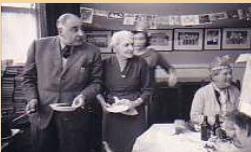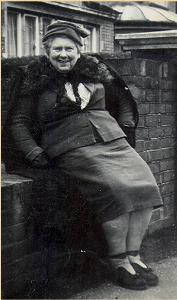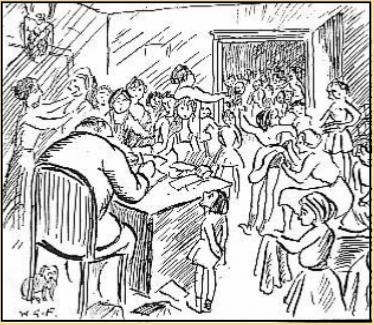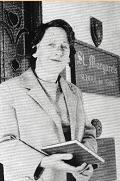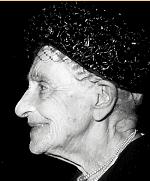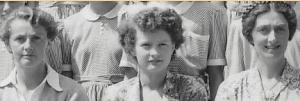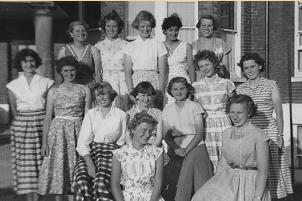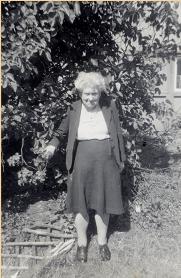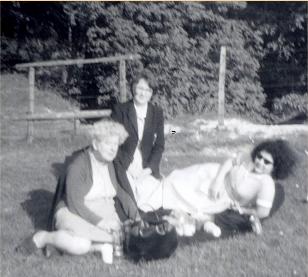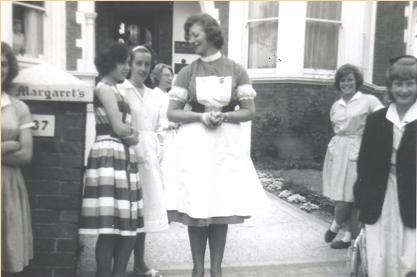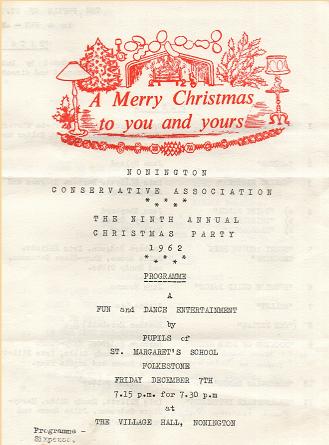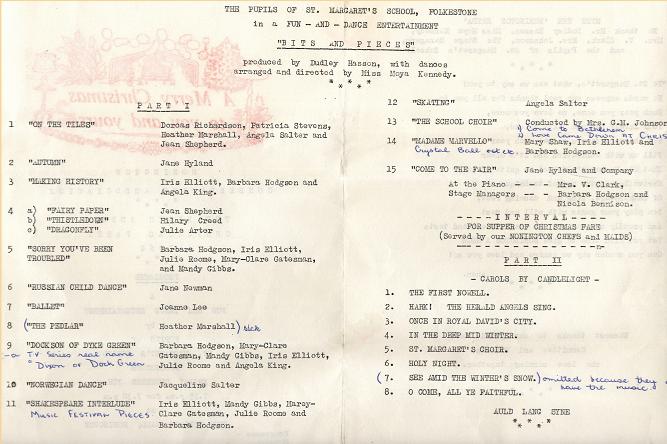Kiwi gifts
In 1948 St Margaret's was "adopted" by Avondale College, Auckland, New Zealand, who sent what was described as "two very welcome parcels of food delicacies".
Grimston Avenue and the School playing-field, painted by Caroline Thomas from the top floor of her family's house in Shorncliffe Road.
The School museum
Some Old Girls may be surprised to learn the source of many of the curios that comprised the little natural history museum. Bill Aird, the stepfather of Gillian Chesterman acquired them from his aunt Amy Collins, whose house in Capel-le-ferne on Dover Hill had ten rooms packed with antiques and curiosities. Bill and his father were the executors and took four months to sort it all out. He offered some to St Margaret's, and Mr Hasson agreed to take some large boxes of items.
Bill's father had owned the Valiant Sailor public house and most of the land between Capel and Sugar Loaf Hill on which he farmed. He had a milk business and supplied Miss de la Mare in the early 1920s. Bill remembered riding on top of a hay waggon on the spot which is now the entrance to the Channel Tunnel.
Bill was keen on cricket and was captain of the Folkestone A-team for five years. He played in some of the School's fathers' matches, and umpired at one of them.
Cat on a glass roof
One of Mr Hasson's favourite stories from his wartime bomb disposal activities was the old lady who thought a bomb had come through her conservatory roof. Mr Hasson went to disable the device, only to find it was a cat.
Margaret of Antioch, saint and martyr
The story of St Margaret is surrounded by myths and legend. She is also known as St Pelagia and St Marina, or perhaps elements of her story were transferred to her from these saints.
She was born in Antioch in Syria some time during the 3rd or 4th century. Her mother died soon after giving birth and she was brought up by a Christian nurse who later adopted her. This horrified her father, a pagan priest, and he disowned her. She went to live in the country tending sheep, where a Roman official spotted her and proposed marriage provided she renounced her faith. She refused, and attempts were made to torture her, but divine intervention protected her from flames and boiling water. She finally met her end by decapitation.
She is often represented in male clothing, but that is probably a legend connected with an actress from Antioch who was converted to Christianity, dressed as a man in order to travel to Jerusalem and lived as a recluse in a cave on the Mount of Olives, practising severe penances. The dragon portrayed with St Margaret represents the devil, and his submissive posture beneath her feet symbolises her dominance over temptation. Margaret is said to have provided the 'voices' that inspired Joan of Arc. She was popular among medieval artists who believed that she had once promised to pray for those who preserved her memory. Like St George, she was one of the fifteen saints said to be effective at praying on behalf of ordinary people and their daily needs.There are several hundred churches dedicated to her in England, many of them in Norfolk. In the Western Church, St Margaret's Day is 20 July.
In 1959 the English mistress Dr Esmé Pole Stuart PhD JP presented the school with a statue of St Margaret and the dragon. This was hung above the entrance door of the New Hall so that the girls saw it as they filed out after assembly.
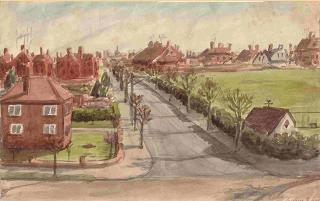
The hospital lift
St Margaret's girls raised over £200 to provide a lift in Folkestone's main hospital, and a brass plate recorded their gift. In 1927 it became necessary to replace the lift with a 'modern' electric one,. The hospital management told the Misses de la Mare that they had taken the brass plate down and suggested that the School might "care to make a special effort towards the new lift, and so have the plate reinstalled." This made the Old Girls see red, and their secretary, Alice Bugler replied indignantly that they had no intention of doing any such thing, but that the brass plate should be replaced in the new lift. The hospital apologised for being so cheeky and agreed to replace the plate amended to read "The original Lift was presented etc." A happy compromise, and a demonstration that the Old Girls were a force to be reckoned with!
A new playing field!
"The first thing to do after purchasing the land in October 1928, was to persuade those who had here cultivated flowers to clear the ground --- a sore trial which all lovers of their gardens will appreciate. The next step was to make a contract for the development of the ground into a playing field. After interviewing representatives of many firms the works was entrusted to Messrs. Sutton and Sons, of Reading. There was a slight fall in the ground from the south to north and after cleaning the land the contractors proceeded to level, at the north end, a space 242 feet by 110 feet, large enough for five tournament courts. In doing this a space in the north-east corner was left unlevelled and was set apart for the pavilion. The drop was too slight to necessitate the levelling of the rest of the ground, any part of which is suitable for tennis courts..... Early in the spring small privet bushes were planted to form a continuous and high hedge on the south and north sides, Cupressus being used for this purpose on the west side."
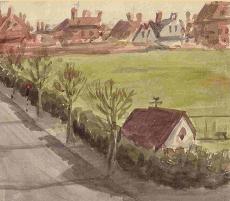
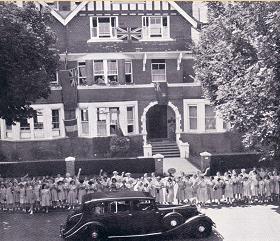
A princess passes the School
HRH Princess Margaret passing the School on 1 July 1952. Mr and Mrs Hasson were among the guests when she inspected the Royal Victoria Hospital after lunching at the Grand Hotel. Judging by the shadows she was probably on her way from there down Earl's Avenue!
Gunner, Mr Hasson's beloved dog, with Sally Harris in 1954.
The Queen smiles at St Mags
On their way home from a state visit to the Netherlands the Queen and Prince Philip visited Folkestone and passed along Shorncliffe Road where the entire school lined up to welcome them. Mr Hasson had been a guest at a reception in the Leas Cliff hall, together with three St Margaret's girls: Ann Croft (Head Girl), Gohar Ebrahimzadeh (Deputy) and Deidre Judkins.
Corner of the Natural History Museum
A trip to the beach with Mrs Wicker in 1951 or 1952. Back row, 2nd from left = Angela Bunbury, 4th from left = Susan Shepherd, centre front in cardigan = Diana Rogers, far right front = Susan Rogers . . . more names, please!
Some later Juniors (1963). Far left: Karen Lawson. Third from left: Bridget Hogben. More names please!
Boarders who could not spend Christmas at home were entertained by the Hassons at the School. Here is Granny Hasson helping to serve.
Where is Toto in the picture below? If you don't know, go to History page, then Story of the School, and the chapter about the Nieces.
Miss Maggs, dressed up to the nines, with School cloak on top, after Prize Giving in 1964, outside the Hall in Grimston Gardens.
CLUBS
The Diddums Club was founded around 1948/9 while I (Caroline Thomas) was in Miss Warren's Form 1, aged 7-ish. I was in charge, of course, the Chief Diddum. My best pals were ranked as Diddums, while the others were at a lower rank known as Ampoos. There were a few boys in the class, and they had their own rank on account of being male, known as Redskins, the lowest of the low in the hierarchy. As for the aims and objectives of this elitist society, all I can remember is that it gave me the chance to be bossy, sexist and classist to my heart's content. I grew out of most of these faults, but I am still bossy.
The G-Club came later, and consisted largely of me (Caroline), Elizabeth Harrison and Madeleine Dobson. G stood for Ghost, and our secret sign was the fist-on-fist gesture used by signers (which we used to call the Deaf 'n' Dumb Language). We would sit in the dark in Maddy's nearby home and tell each other ghastly grisly ghost stories, thereby fulfilling the club's aims in accordance with its unwritten constitution.
The Hearty Jokers' Club was formed by the Lower Third Class in 1955.The main retrobates were Geraldine Richmond, Felicity Jay, Jennifer Aird, Penny Stanford and Carola Barrett (aka Barrola Carrot). The initiation into this club was to run down the front stairs in the Junior House and bang on the Staff room door without getting caught during break. Needless to say our source of information was caught out by a member of staff, namely Miss Warren. She got into a lot of trouble and was threatened with expulsion. That did not deter them and from there on they had look-outs placed at strategic places and had the staff running round in circles. Even in those days they voted for who would be in charge (democracy) unlike the dictatorship of the "Diddums" club!
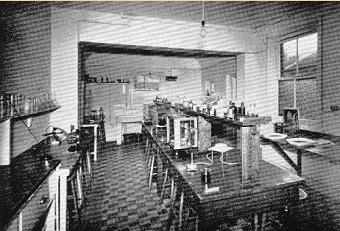
The Science Laboratory in the Lodge, opened 1954. Memories of Irish Mr Furlong with his passion for funghi, which he pronounced foon-guy, and the pickled rabbit for studying the alimentary canal.
Dear Prime Minister
In 1948 form VA wrote to the Prime Minister of Ceylon with congratulations for the island attaining Dominion status. He replied with greetings from Ceylon and good wishes to St Margaret's pupils in their examinations.
Still helping the hospital . . .
In 1949 the St Margaret's girls responded to a plea by the Folkestone Herald for donations for Christmas parcels for patients spending 25 December in the Royal Victoria Hospital. They raised £4 (a lot then), and the Matron wrote in her 'thank you' letter: "I noticed that yours was the only school to have sent a donation. Since presenting the Hospital with its first lift many years ago, St Margaret's has always been to the fore in helping us in a host of different ways . . ." The girls who took the donation to the Folkestone Herald offices were treated to a guided tour of their printing works.
Reception at the Persian Embassy
In 1950 His Excellency, the Persian Ambassador left his appointment in London and, with Madame Rais, held a farewell reception at the Embassy. Among the distinguished guests were Mr and Mrs Hasson. His Excellency's nieces continued to be educated at St Margaret's.
French evenings
The Sixth Form held some French evenings in 1951 attended by members of staff. Charades, games, story-telling and conversation were all in French, including 'Twenty Questions'.
The Webmistress remembers Miss Brown in Form 2, about the same time, running Bingo sessions. Well, they were called French Picture Lotto, actually. We had boards with garishly coloured pictures of Le Papillon, La Maison and so on, and when she called out the word we had to know which picture to cover up.
Tuck shop
The School Tuck Shop was opened in January 1952. Was this the one in a cubby-hole at the top of the Lodge? The Webmistress remembers finding a sweet on the floor outside it and wondering whether to hand it in to some authority, but decided to eat it, and then had pangs of conscience. (Pious little prig.) Later she was one of the prefects in charge of the new tuck shop in the new hall. Oh, the power of being able to decide the ratio of barleysugar sticks to sherbet flying saucers! Mr Weir presented a pair of scales to the tuck shop in 1955.
A quiet lunch-break in the Study
CORONATION DAY 1953
This was an official school holiday. At St Margaret's it began with prayers for Her Majesty, then crowding round the radio to hear the coronation taking place, lunch, an appropriate film show, Juniors' tea-party with games,competitions and red-white-and-blue jellies, waited on by the Prefects. Rain in the evening spoiled the floodlit garden and drove everyone indoors, but they still enjoyed dancing and more competitions including Mrs Hasson's treasure hunt. A number of parents joined in the fun. The Prefects had set out a beautiful buffet and the party ended well after midnight. Every pupil received a gilt brooch of the Royal Cipher, and the Folkestone Corporation gave seniors a coronation spoon and juniors a souvenir beaker.
Magic!
'Devla' was the stage name of the Milton sisters' father who, apart from playing in the Fathers' Cricket Match, entertained the girls from time to time with his conjuring tricks. Caroline Thomas remembers volunteering to be a 'stooge' on the little stage in the old assembly hall in the main building, and consenting to put her hand through the hole of Mr Milton's guillotine which had just neatly sliced a potato in half. A waste-paper basket stood beneath to catch the severed hand. What worried her most was how to explain to Miss Rudman at the next piano lesson why she had not been able to practise. She began to sweat --- "Abracadabra" --- down came the blade, but her hand remained attached. Phew!
Tudor furniture
Under Miss Goddards' direction, the Lower Third made models of tudor furniture, which were exhibited at the NUT Conference at Easter 1955, arousing great interest.
Influenza!
The Michelmas Term of 1957 was only four days old when the School succombed to the 'flu. Within six days about 100 boarders and 100 day-girls were victims, as well as Miss French (second Matron) and other members of staff. When the Sanatorium was full other rooms were converted into sick-rooms, and Mr Hasson, Matron, Miss Cronin and others worked day and night. Doctor came two or three times each day. After twelve hectic days all was back to normal.
Mr Hasson was elected a Fellow of the Royal Society of Arts in November 1957.
Wanted: a small actress for television
The Folkestone Publicity Officer asked the School to supply a small girl for an ITV programme about the town as a holiday resort. Dorcas Richardson was chosen, and had to play with bucket and spade on the beach --- in November!
East Kent Road safety Quiz 1961/62
This was a series of eliminating rounds that culminated in the much coveted East Kent County Shield. St Margaret's team consisted of Julie Roome (Captain), Lyndsay Boyce, Gillian Chesterman, Jean Bristow and reserve Vivienne Moncrieff. All competitors were under 15 years old.
In the first round, St Margaret's beat five other Folkestone schools. They were coached by Sgt Ayres of the Folkestone Police, helping them to beat the best teams from Hythe and Ashford and finish a clear 12 points ahead. The next stage, the semi-fnals, was a close win against grammar school boys from Sandwich, and the finals were against the Girdlers School in Herne Bay who had won in the previous two years. But St Margaret's beat them and gained the East Kent County Shield. Yet again the School demonstrated that hard work, team spirit and plenty of guts could bring success.
In the years to come, St Margaret's won the Folkestone trophy again and again, and won the finals again in 1963/64. Their road safety knowledge was clearly a force to be reckoned with.
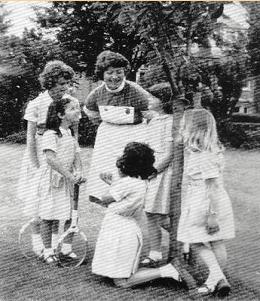
Head Matron, Sister Bell, with some juniors in 1964.
Maths survey
In 1964 a cross-section of St Margaret's girls of various ages took part in an international survey of the teaching of mathematics. The average mark for the tests conducted in Britain was 27.8%, and for all countries 28.2%. St Margaret's own average? 40.7%!
Miss May
Miss Christine May BSc(Hons), FRGS was appointed Headmistress of St Margaret's in 1966. educated at Leamington College for Girls,awarded a scholarship to Birmingham University and graduated in 1952 with honours in Geographby, qualified as a teacher in 1953. She moved to the School from Hornchurch Grammar School. One of her first changes was to introduce Current Events into the Sixth Forms and arrange lectures and expeditions. She deserved a longer term of office to bring her ideas to fruition.
First Year VI, 1955
Susan Hays, Pam Allcock, Pauline Jones, Afsar, Anne Hole, Diana Warner, Maureen Chiverton, Brenda Williams, Margaret Weir, Julie Mannering, Marilyn Preece, Thelma Deavin, Margaret Harrison , Julie Cotton
Caroline Hardy remembers Granny Hasson explaining to her exactly where to punch someone on the jaw in order to knock them out. We certainly got an all-round education at St Mags.





